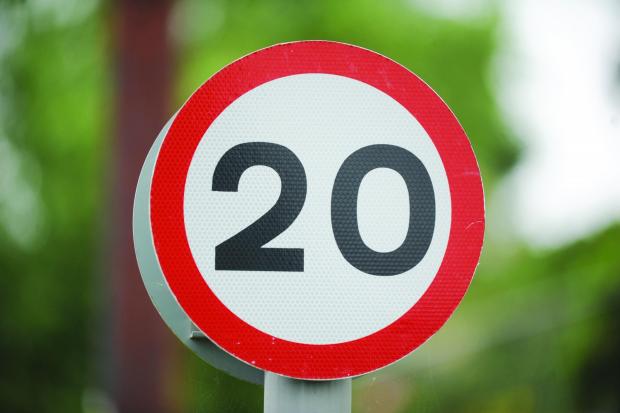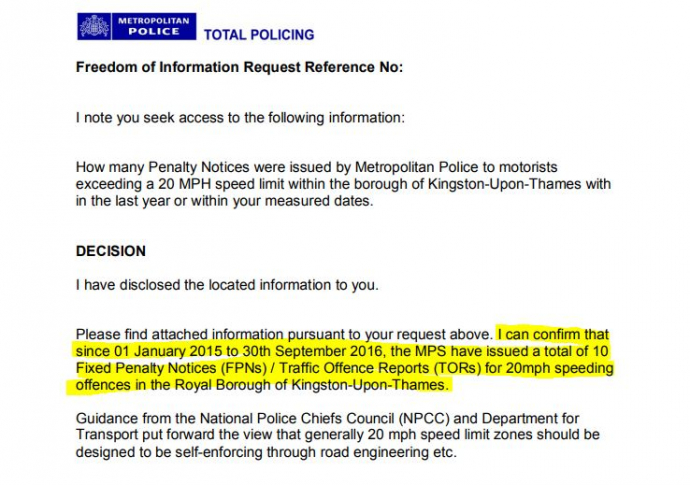
20mph zones hold the key to safer streets in urban areas, but the efficacy of these lower speed limits suffers a double whammy of enforcement levels so low they’re statistically insignificant and road design that encourages a flouting of the law.
Don’t get us wrong. Here at the ETA, we’re proud to have helped coin the phrase “Twenty’s plenty” and thrilled that over the years it evolved into 20’s Plenty for Us, a campaign group we continue to support.
Given the number of deaths and serious injuries on our roads, there is no justification for 30 mph as the national speed limit. According to 20’s Plenty for Us, “The 30mph limit that was plucked out of the air in 1934 as being better than no limit, is no longer fit for purpose. It is unjust, unjustifiable and needs to be consigned to history.“
There is no doubt that 20mph limits have numerous benefits. The introduction of 20mph speed limits in areas of London has contributed towards a 50 per cent reduction in the number of children killed or seriously injured on the roads (see British Medical Journal) – these zones not only reduce casualty figures, they improve quality of life by transforming streets into areas where people are happy to cycle and children are able to play.

| 87% of drivers flout a 20mph limit if they have the chance to
However, while the benefits of 20 mph limits are indisputable, enforcement remains a challenge. The Metropolitan Police oversees roads that see 5.5 million car trips every single day. Given that according to research by TfL, 87% of drivers break a 20 mph speed limit when they have an opportunity to do so, and that one third of London’s streets are now subject to a 20mph limit, take a guess at how many drivers in London are penalised for breaking a 20 mph limit on a typical day. The answer is 117 – a figure so low as to be statistically insignificant and of particular concern in a city with a Vision Zero commitment to eliminating all deaths and serious injuries by 2041.
One particular outlying London borough penalises one motorist every two months.

Guidance from the National Police Chiefs Council and DfT put forward the view that generally 20mph speed limit zones should be designed to be self-enforcing through road engineering. This might be a rational position to take if it wasn’t for the fact that for the most part 20mph road engineering comprises a small road sign. Far from calming speeds, most urban and suburban roads feature long and wide stretches – an arrangement that encourages higher speeds.
While the enforcement of 20mph zones remains in a no-man’s land between cash-strapped police and local authorities, we fail to reap its full potential and motoring groups use it as an opportunity to lobby against the widespread introduction of lower speed limits. The AA imply that drivers are incapable of adhering to the law and that 20mph limits exist to keep drivers below 30mph. It’s a perverse logic that not only ignores the proven benefits of lower speeds but overlooks the corrosive effect on society of any law that is almost universally flouted.

As the nationwide network of 20mph zones continues to grow, it’s vital that effective road engineering and robust police enforcement go hand in hand to ensure it delivers its full potential.
Your journey, our world
We were established in 1990 as an ethical provider of green, reliable travel services. Twenty-nine years on, we continue to offer cycle insurance, travel insurance breakdown cover and home insurance while putting concern for the environment at the heart of all we do.

Philip
There are a couple of points to note here.
Firstly 20mph is a very engine inefficient speed to maintain since it involves staying in a low gear. This results in higher CO2 emissions, causes more pollution, and is harmful for the environment.
Secondly, police forces are not “cash strapped” Please stop using this lazy phrase.
They choose to spend their significant budgets in other areas. Pay and pensions for relatively early retirement using up a considerable amount of their allocated budgets.
Joel
The lower speeds do not increase pollution, quite the opposite.
The ETA
20mph limits assist in encouraging a modal shift away from residential streets being predominantly the domain of motorised vehicles and not pedestrians and cyclists, they help prevent people being run over and killed by cars and research has found that they need not increase pollution as you suggest. Research in Germany has shown that the greater the speed of vehicles in built-up areas, the higher is the incidence of acceleration, deceleration, and braking, all of which increase air pollution. The research indicates that traffic calming reduces idle times by 15%, gear changing by 12%, brake use by 14%, and fuel consumption by 12% (Newman and Kenworthy 1992, 39–40). This slower and calmer style of driving reduces emissions, as demonstrated by an evaluation in Buxtehude, Germany. Even aggressive driving under the slower speed limit (20mph) produces lower emissions (but higher fuel use) than under the higher speed limit (30 mph), although calm driving produces greater reductions for most emissions and net fuel savings (Newman and Kenworthy 1992, 39 –40).
Between 2010 and 2017 there has been about a 20% cut in police funding in real terms
S Peterson
if Philip got rid of his high polluting car that would solve his problem. Motorists have far too many rights at the expense of pedestrians and cyclists. He might as well get used to more restrictions on his freedoms especially where they impinge negatively on everyone else.
Matt Hodges
The reference to 20 MPH Zones is misleading. I understand that originally 20 mph Zones were required to have traffic calming engineering such as chicanes and speed humps and were expected to be self enforcing. Then it became possible to apply 20 mph limits (possibly under separate legislation??) without engineering. Just Signs at the start and repeater signs.
Lancashire had some 20mph zones but they were expensive to create with all the speed humps etc. then a few years ago the council adopted a policy of applying a 20 mph Limit on all residential roads that were not main through roads. I think the budget for the signs and TROs was about £9M. Now most residential roads that were not already in 20 Zones have 20 mph limits. Also many minor through roads in estates and villages also have 20 mph limits. Unfortunately there is little if any enforcement.
Various petrol heads have used the rising number of casualties on 20 mph roads to claim they are ineffective. This is deceitful rubbish. The number of casualties on 20 mph roads are increasing as there are more 20 roads while the number on 30 mph road are falling with the major reduction in mileage of 30 mph roads. The accidents on 20 mph roads are less than the accidents on those same roads when they were 30 mph.
What is really needed is a default 20 mph limit on built up roads with the Highway Authority having the power to raise the limit on suitable major distributor roads. Enforcement should be delegated to local authorities like enforcement of parking restrictions. The police won’t enforce speed limits properly as they don’t want to be unpopular with large numbers of irresponsible drivers.
Mark
I wholeheartedly support 20mph limits much more widely. I agree that having but not enforcing them undermines laws more widely, but what are the figures on speeds on those roads before and after they were reduced from 30mph? Given that even a 5mph reduction in speed has a much greater effect on road safety, that’s something to be thankful for already.
Maybe it’s too mathematical to use, but I have always wondered why “potential time saved” is not used in campaigning for 20mph, given that saving time is the main reason people give for speeding or complaining about 20mph limits.
I figure that it will be easier to average close to 20mph on a 20mph road than close to 30mph on a 30mph road (slowing for ‘obstacles’ like kids on bikes and for junctions, and speeding up again to ‘fully speed’ will take less time).
As distributor roads would be by definition excluded from 20mph limits, most trips will involve probably less that a mile on 20mph roads.
1 mile at 30 mph (which is generally unachievable even if speeding as stated above) takes 2 minutes.
1 mile at 20mph takes 3 minutes.
This means that at the very best most journeys would be extended by a few seconds, certainly not any significant number of minutes.
These “carpark” figures illustrate the point I think, but it would be great to know the actual effect on journey times. And then to make the point that it’s not worth increasing risk and discomfort to residents for a few seconds at the other end.
Daniel Russell
What a load of nonsense after driving for 20 years as a necessity for my job there was no warning or understanding that the habitats of drivers like myself physically are used to driving safely at certain speeds that the vehicle is geared to perform at with due care and attention, i have excellent reaction times. There was no warning letter for the first time offence to these new measure unlike the other million measures such as yellow boxes, bus lanes, congestion charge, ULEZ. At least the Dartford bridge toll gave motorists warning letters but not this lot, i have been targeted and penalised for 24mph 3 times once at 2:00am which is ridiculous, obviously this is about money, control and an ideology against cars. (I have never had a speeding ticket before this.) Councils are now run by incompetent people with fixed ideology, this is the pathetic way our once great nation wastes money. How about electric cars or not cycling on the road till you’re qualified to do so as it’s dangerous for you and your family regardless of speed, cyclists should require insurance, indicators, break lights and a license. There has been no survey of who uses the road and for what, people are being punished for living a normal considerate life and being hit with extreme tyrannical measures that add up to hundreds and thousands in insurance costs for points given while driving on main roads under 30mph-.Also different boroughs have different rules, that’s incompetent, illegal and lacking communication. Lewisham council for example wants to loose 80% of cars on the road which is laughable as it’s no idea who uses the road plus it’s a borough that people ise to drive through to get to other places in London it’s not a countryside village. If pedestrians are more responsible and pay attention to their children instead of dreaming of more likes while looking at their phone we wouldn’t be here, soft soft soft wet tissues you lot are. Also remember it’s good to have the chance of being run over that way you can appreciate life is something to not take for granted and you should take responsibility for yourself and family instead of blaming innocent people that are struggling for money, be ashamed of yourselves, you’re small minded unworldly people that are selfish and uncharismatic.
The ETA
Surely this is satire?
Ralph
WHO SHALL WE DO TODAY (POLICING BY CONSENT)
Government responds (eventually) to public demand by creating laws and regulations that the police are supposed to enforce. Sometimes the police consent to to have a ‘purge’, usually for a week. Then the selfish drivers know it’s ok to revert to type.
Tim
I’ve been trying to find concrete evidence that 20mph has a material effect on accidents, and anything at all on the costs of 20mph. The DfT evidence seems to rely on a comment from WHO, that lower speed limits save lives, primarily in developing countries. I cannot find anything that tries to measure/estimate both costs and benefits, so that the sort of benefits case that NICE does for medicines can be established.
In UK, accident and deaths continue to fall. It’s not clear if this is due to fewer journeys, less traffic, changes in measurement, safer vehicles, safer roads or something else. The long term trend is 3% fall per annum for 30mph zones (based on ONS numbers between 2005 and 2019, http://bit.ly/2U0h2hS), much less for others. 20mph zones have increasing accident rates, presumably as their size and count increases.
One thing that is striking is the daily variation for 30mph zone accidents, compared to other road types.